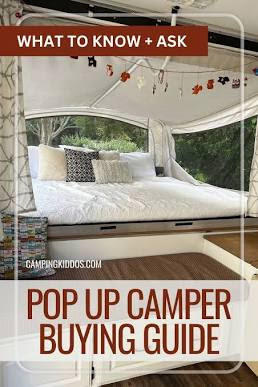Pop-Up Camper Buying Guide: 13 Essential Things to Know
When considering a pop-up camper, it’s important to gather all the necessary information before making a purchase. Whether you're new to RVs or an experienced traveler, understanding the pros and cons will help ensure you're making the right decision. This guide will cover essential factors to consider when buying a pop-up camper.
1. Price Range
Pop-up campers come in a wide range of prices. Typically, these trailers are more affordable than motorhomes or larger RVs. New pop-up campers typically cost between $4,000 and $13,000, compared to travel trailers starting at $8,000. Motorhomes can exceed $100,000. Popular brands like Jayco, Aliner, Rockwood, and Sylvansport offer quality campers, but their prices may be higher.
If you're on a budget, consider looking for a used pop-up camper, as these can be more affordable and offer significant savings.
2. Buying a Used Camper
Used pop-up campers are an attractive option if you're trying to save money. However, be aware that the condition of used trailers can vary greatly. While the initial cost might be lower, repairs could be costly. Make sure to inspect the camper carefully and check for any potential issues that may require repairs.
3. Additional Costs
The cost of the camper itself is just the beginning. To optimize your experience, you may need to purchase smaller, collapsible appliances, storage solutions, and other accessories. Miniature BBQs, compact coffee makers, and collapsible trash cans are just a few examples of space-saving items that can make your camping experience more convenient.
4. Thin Walls and Climate Control
Pop-up campers are lightweight and compact, but their thin walls provide minimal insulation against extreme temperatures. Be mindful of the climate when choosing a pop-up camper. Not all models come with built-in heating or air conditioning, so you may need to supplement with portable fans, heaters, or even propane options to stay comfortable.
5. Noise Levels
Due to the thin walls of most pop-up campers, they are not ideal for blocking out external noise. If you're camping near others, noise from generators or nearby campers may be more noticeable. For a quieter experience, consider using earplugs or choosing a location far from other campers.
6. Ideal for Active Travelers
Pop-up campers are perfect for adventurous individuals who enjoy boondocking and exploring remote areas. These campers offer flexibility, allowing you to camp in various locations without the restrictions of larger RVs. Additionally, many models can be towed off-road, making them a great choice for wilderness adventures.
7. Space Limitations
Pop-up campers come in various sizes, with some models offering space for up to eight people. However, the compact design means that privacy and personal space can be limited. Be prepared for close quarters, especially when traveling with family or a group.
8. Basic Bathroom Facilities
Pop-up campers generally don't come with full bathrooms. While some higher-end models include a small bathroom or shower, others rely on nearby campsite facilities or portable toilets. If having a bathroom on board is a priority, look for a model that includes these amenities.
9. Beginner-Friendly
Pop-up campers are a great option for beginners due to their lightweight design and ease of towing. They can be towed by most vehicles, though it's important to ensure your vehicle can handle the camper's weight. Practice towing, parking, and maneuvering the camper before heading out on your trip.
10. Storage and Maintenance
Storing and maintaining a pop-up camper is easier than larger RVs. Most models are compact enough to fit in a garage, and the maintenance required is relatively minimal. However, you’ll need to take extra care to keep the camper clean, prevent mold and mildew, and monitor the condition of the tires.
11. Setup and Takedown
Setting up and packing down a pop-up camper requires time and effort. Many models involve hand-crank systems and support poles, and the setup process can be physically demanding, especially in less-than-ideal weather conditions. Be prepared to invest time and energy in making sure your camper is properly set up for each trip.
12. Personal Preferences
Before making a purchase, consider your personal needs. If you prefer additional space, a model with slide-outs or a larger dinette may be more comfortable. Think about whether you need a bathroom or other specific amenities, and make sure to check the camper's floor plan and available features.
13. Renting Before Buying
If you're unsure about purchasing a pop-up camper, consider renting one first. Renting allows you to test out different models, get used to towing, and experience life in a pop-up camper before making a long-term commitment.
Conclusion
Pop-up campers offer a unique blend of portability, affordability, and adventure, but they’re not for everyone. Understanding the pros and cons, considering additional costs, and ensuring the camper fits your lifestyle are key to making a satisfying purchase. Whether you're a first-time RV owner or an experienced traveler, a pop-up camper can be a great way to explore the outdoors with the right preparation and mindset.
#PopUpCamper #Outdoors #Camping #Survival #BuyingGuide #EssentialThingstoKnow #ThingsToKnow







